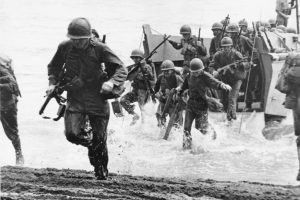For eight months in late 1942 and early 1943, the fate of a lightly inhabited set of islands in the Southwest Pacific captivated the attention of the United States and Japan. The spectacular American victory at Midway had destroyed four Japanese aircraft carriers and effectively ended the Japanese advance of spring 1942. After much debate, senior U.S. commanders decided on Solomon Islands as the target for the first Allied offensive in the Pacific.
From August 1942 until February 1943 the Americans lost two aircraft carriers and numerous cruisers, while the Japanese lost two battleships, one aircraft carrier, many smaller vessels, and (perhaps most importantly) a huge number of aircraft and trained aircrew. On land, Japanese forces suffered some 30,000 casualties against 15,000 for the Americans.
The Guadalcanal Campaign, more so even than the Battle of Midway, tore the heart out of Japanese naval airpower.
Eighty years later, the Solomons have again attracted U.S. strategic interest. Two years after enticing the government of Solomon Islands to drop its diplomatic recognition of Taiwan, the People’s Republic of China has concluded a security agreement with the archipelago. Rightly or wrongly, this has raised concern in Washington and Canberra and inevitably evoked memories of the bitter battles of the 1940s.
The Setting
Japanese troops landed unopposed at several points in the Solomons in April 1942. At the time, the islands were occupied by indigenous inhabitants (mostly working in fishing and subsistence agriculture, or on a few large plantations owned and operated by the colonial authority) and a few European overseers.
Unlike the Dutch East Indies and the British colonies of Southeast Asia, the Solomons presented little economic value to the Japanese. Instead, they offered the opportunity to build bases that the Imperial Japanese Navy (IJN) and its air forces could use to attack supply lines between Australia and the United States. The critical Japanese strongholds in the eastern Solomons were Tulagi, which had a natural harbor, and Guadalcanal, which was large enough to build a substantial airfield.
In the wake of victories at the Battles of Coral Sea and Midway, the Allies were on the lookout for a chance to go on the offensive. They were aware of the threat posed by further Japanese encroachment in the South Pacific to logistical ties with Australia, and Pacific commanders believed Guadalcanal to be an ideal target. After some sparring with General Douglas MacArthur in Australia and the Europe First lobby in Washington, the operation was given a nod.
On August 7, 1942 U.S. marines landed at four beaches in the Solomon Islands chain, including Tulagi, two smaller islands, and Guadalcanal. Over the next seven months, the Japanese and the Allies fought bitterly over control of the islands in an escalating series of seesaw land, air, and sea battles, the outcomes of which often seemed to dance precariously on the edge of a knife.

































